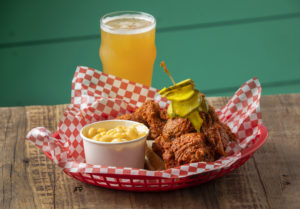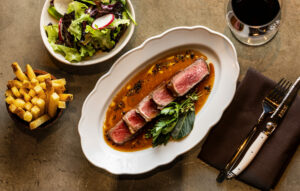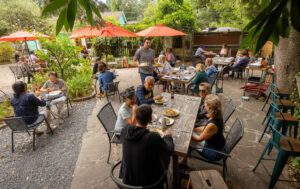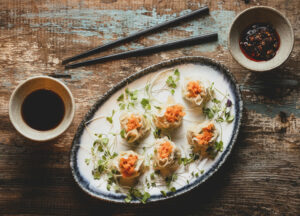 I may have seen a cloud this week, but if I did, I don’t remember it.
I may have seen a cloud this week, but if I did, I don’t remember it.
Really, our weather has been impossibly nice. And really, it ought to worry me – the lack of rain, the risk of budbreak before a frost – but it’s hard not to simply soak in it, the whole of our little wine country valley like some great, tickly bubble bath of pea shoots and sunlight. As you can plainly see, my magnolia tree remains entirely convinced that winter’s gone packing, despite the certainty of our path along the earth’s elliptic, and I suspect my grapes and roses are taking notes.
 Whether it’s the unseasonable warmth or some other circuit breaker in the soil, my oranges have never been sweeter and are staging a revolt: Pick us now! Or we’ll jump to our deaths! The challenge with even the smallest of orange trees, of course, is how to use all that fruit, the byproduct of the tree’s profligate attempts at procreation: I’m not above using them for decoration, for starters. A pitcher of juice, which I’ll first strain, with Sunday brunch. And come our turn for snack, a teeming orange kindergarten, chubby little faces full of silly smiling wedges.
Whether it’s the unseasonable warmth or some other circuit breaker in the soil, my oranges have never been sweeter and are staging a revolt: Pick us now! Or we’ll jump to our deaths! The challenge with even the smallest of orange trees, of course, is how to use all that fruit, the byproduct of the tree’s profligate attempts at procreation: I’m not above using them for decoration, for starters. A pitcher of juice, which I’ll first strain, with Sunday brunch. And come our turn for snack, a teeming orange kindergarten, chubby little faces full of silly smiling wedges.
But the greatest number, like uncountable generations before them, will meet their maker on the glass steeple of my great-grandmother-in-law’s juicer. At least, I think that’s where it came from, the Alabama kitchen of my wife’s mother’s youth, a vaguely Confederate past I try not to hold against the thing itself. Regardless, it’s a wonderfully dated piece of kitchenware, profoundly lo-tech and familiar in that way that only things first used by other, older hands can be, the sort of tool you never really own but merely take care of until it’s no longer your turn. It’s chipped, of course, somewhere along the base, but I’m not giving it up until it draws blood, and maybe not even then…
At least, I think that’s where it came from, the Alabama kitchen of my wife’s mother’s youth, a vaguely Confederate past I try not to hold against the thing itself. Regardless, it’s a wonderfully dated piece of kitchenware, profoundly lo-tech and familiar in that way that only things first used by other, older hands can be, the sort of tool you never really own but merely take care of until it’s no longer your turn. It’s chipped, of course, somewhere along the base, but I’m not giving it up until it draws blood, and maybe not even then…
 In any case, I’m not really a juice person, and I prefer my food more salty than sweet, so my first inclination was to cook all that fruit into something savory. This presented a minor technical challenge because of all that natural sugar, but that’s why some god with a palate gave us vinegar, and why I decided to try my hand at a gastrique, a simple sauce consisting of little more than sugar, fruit, and some sort of acid to balance it out. For the unrepentant sauce slut, particularly the non-professional, the gastrique is a wonderful thing: Requiring as few as three ingredients, one pot, and maybe 10 minutes of marginally active cooking time, the basic formula allows for virtually infinite variation, and is remarkably hard to screw up. This particular version reminds me of that sticky, neon glaze you’d get from the steam tray of a strip-mall Chinese, except that it tastes really good.
In any case, I’m not really a juice person, and I prefer my food more salty than sweet, so my first inclination was to cook all that fruit into something savory. This presented a minor technical challenge because of all that natural sugar, but that’s why some god with a palate gave us vinegar, and why I decided to try my hand at a gastrique, a simple sauce consisting of little more than sugar, fruit, and some sort of acid to balance it out. For the unrepentant sauce slut, particularly the non-professional, the gastrique is a wonderful thing: Requiring as few as three ingredients, one pot, and maybe 10 minutes of marginally active cooking time, the basic formula allows for virtually infinite variation, and is remarkably hard to screw up. This particular version reminds me of that sticky, neon glaze you’d get from the steam tray of a strip-mall Chinese, except that it tastes really good. 
Use it as a glaze, a sauce proper, or a dip; serve it with grilled chicken, shellfish, or with pork chops and rice, as we did last night. Take the basic principle and make up your own: Maybe black cherries, with pheasant or game; a blackberry gastrique with fois gras; or a sweeter, raspberry-tinged version with bitter chocolate cake…
Fresh Naval Orange Gastrique
0.5c Water
0.5c Sugar
2c Freshly Squeezed OJ (or any juice you like, preferably strained)
0.5c Rice Wine Vinegar (or Sherry, White Wine, or whatever you have to hand)
Pinch of salt and fresh white pepper, to taste (optional)









